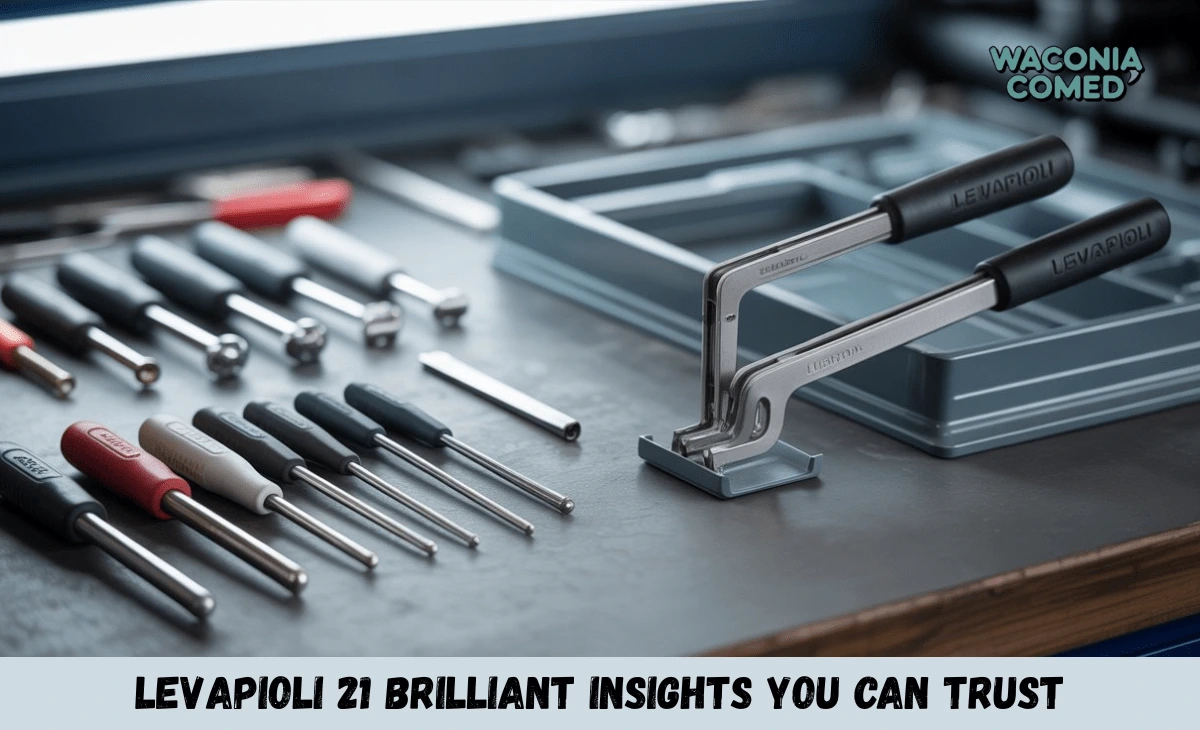Many people hear the term levapioli and wonder what it is, yet the answer is refreshingly simple. In Italian workshops and tool catalogs, levapioli refers to a compact lever designed to lift pins, pegs, or plastic fasteners cleanly. Think of it as a purpose-built pry tool that slides under clips and lifts them out without scarring panels. In automotive trim work, it’s known as leva per pioli, or “lever for pegs,” and is prized for gentle, controlled removal. It’s not a fancy marketing term—it’s a workhorse in careful disassembly.
What levapioli Really Means Today
Across workshops, levapioli has two main meanings. First, it names the actual tool: a slim, angled lever that gets beneath fasteners where fingers or bulky tools won’t fit. Second, it represents a careful approach to taking things apart—a mindset that values precision over brute force. Mechanics, restorers, cobblers, and even electronics hobbyists use it to reduce damage, downtime, and replacement costs. Its geometry fits delicate materials, multiplying your effort without the risk of damage.
Origins of levapioli in Italian Craft
The word breaks down into two parts: leva (lever) and pioli (pins or pegs). Old-world craftsmen used small levers to tease out tacks, nails, and wooden pegs from furniture and shoes, protecting the workpiece for reuse. Over time, toolmakers refined the design with broader blades, softer edges, and ergonomic grips so artisans could work faster without surface damage. Today’s versions carry that heritage forward, adapted for modern materials like ABS plastic, soft-touch surfaces, and painted trim.
levapioli in Modern Workshops
In a modern body shop, levapioli tools are found alongside clip bins and trim kits. When a door panel rattles or a dashboard creaks, technicians use them to lift panels without twisting or breaking clips. The levapioli’s thin blade reaches behind the panel, finds the clip head, and lifts it straight out. This ensures the substrate remains intact—a major reason professionals choose it over improvised tools like screwdrivers.
How a levapioli Works Without Damage
Two design principles make the levapioli effective: contact area and lever geometry. Its blade is thin enough to slip between the panel and clip, yet wide enough to distribute force evenly. By using a proper fulcrum point and lifting in line with the fastener, you reduce stress and avoid breakage. Forked tips cradle the clip head, while slight offsets improve access in tight spots. Nylon and composite blades are gentler on finishes, while polished steel versions provide extra force for stubborn clips.
Types of levapioli You’ll See
The family of levapioli tools includes flat wedge blades for general work, forked tips for rivet-style clips, and hooked profiles for recessed fasteners. Kits often combine nylon blades with rigid metal levers, allowing you to match the tool to the job. Nylon is best for delicate surfaces, while steel handles tougher, more stubborn fasteners.
Choosing a levapioli for Automotive Work
The right levapioli depends on the car and task. For painted or soft-touch surfaces, nylon or composite blades are safest. For tight, stubborn clips, a steel model with a polished, rounded edge works best. A medium-length forked lever is ideal for door cards, while a slim, offset blade excels in dashboard and radio panel removal.
Shoemaking Uses of levapioli
In shoemaking, levapioli is a go-to for tack removal. It slips under sole nails and lifts them without scaring the leather. Since leather and stitching can be easily damaged, the gradual ramp and flat face of the tool are essential. This careful tack removal preserves the shoe’s integrity, readying it for new soles without aesthetic compromise.
levapioli and Fine Electronics Repair
For electronics, nylon levapioli blades are perfect for separating bezels, snap-fit cases, and delicate plastic parts. Thin starter blades open seams, while thicker spreaders hold them apart during further disassembly. This method avoids scratching surfaces or breaking hidden tabs, a must for tablets, infotainment systems, and instrument clusters.
Safety First with levapioli
Keep your other hand out of the tool’s path to avoid injury if a clip releases suddenly. Wear eye protection in case small parts eject under tension. Use protective shims when prying near painted edges, and always pull in the fastener’s axis to minimize damage.
levapioli vs Screwdrivers and Putty Knives
While screwdrivers and putty knives can pry things apart, they’re prone to damaging materials. A levapioli is designed specifically to grip and lift clips without twisting or gouging. Its broader tip, forked design, and ergonomic handle provide better control and safer results.
Pro Techniques: Panel Clips and Hidden Fasteners
Map out clip positions before lifting a panel. Start from the edges and lift clips one at a time using short, controlled motions. If resistance persists, check for hidden screws before forcing anything. In complex panels, insert a second nylon blade to maintain a gap as you work.
levapioli Maintenance and Care
Wipe steel tips clean after use to prevent rust, and smooth any burrs to keep the blade glide-friendly. Sand down mushroomed nylon edges to restore shape. Store your tools in a protective roll or tray to avoid tip damage, and clean handles regularly for a better grip.
Spotlight on Reputable levapioli Brands
Several brands produce high-quality levapioli tools. Some specialize in steel levers for automotive panels, while others offer complete nylon kits for dashboards and delicate trim. Good manufacturers focus on ergonomic grips, durable materials, and precision tip geometry.
Reading Product Specs That Matter
Blade width affects how well the tool slips beneath clips. Offset angles help your knuckles clear obstacles, and blade stiffness determines whether it will flex or apply maximum force. Handle comfort and grip quality are also important for long sessions.
Budget to Pro: levapioli Price Tiers
Entry-level kits offer nylon blades at an affordable price—ideal for beginners. Mid-tier sets mix nylon and steel for broader applications. Premium options feature hardened steel, ergonomic handles, and durable composite blades for professional use.
levapioli Kits and What’s Inside
A complete kit often includes thin starters, broad spreaders, forked lifters, and hooked profiles. Some organize tools by stiffness, while others standardize handle design for consistent feel and reduced hand fatigue.
Sustainable Choices with levapioli
By allowing repairs without damaging components, levapioli tools reduce waste. Fewer replacement parts mean less manufacturing, shipping, and landfill impact. A single well-made tool can last for decades, making it an eco-friendly investment.
levapioli in DIY Home Projects
In the home, levapioli excels at removing baseboards, furniture trims, and cable channels. It’s perfect for any clip-based fixture where you want to avoid chipping, denting, or scratching surfaces.
The levapioli Mindset in Design
Levapioli thinking extends to product design—anticipating how items will be disassembled for repair. This leads to clips that release cleanly and service access points that make maintenance easier.
Common Mistakes and Easy Fixes
Avoid forcing a single corner; instead, work evenly along the panel. Always protect painted or delicate edges with a shim. If you hear cracking or creaking, stop and reposition for a cleaner lift.
Troubleshooting Stubborn Clips
Warming the area slightly can make brittle clips more flexible. Using two tools together—one to create space, another to lift—can free difficult fasteners. Light tapping or micro-vibrations also help release stuck clips.
levapioli for Beginners: A Simple Start
Start with an easy project like removing a door speaker panel. Use short, controlled lifts on each clip, and insert spacers to keep gaps open as you work. Reverse the process during reassembly for a secure fit.
Advanced Tricks for Pros
Professionals mix nylon and steel tools strategically. They approach panels from low-stress sides and listen for the “pop” of a clean release. Using shims alongside levapioli prevents re-engaging clips accidentally.
Buying the Right levapioli Online
When shopping online, check material details, dimensions, and tip profiles. Buy from trusted sellers who provide accurate specs and return options. Complete kits often offer better value than single tools.
Future Trends: Smarter levapioli
Expect innovations like modular handles, improved composites, and micro-pry profiles for ultra-thin electronics. The focus will remain on precision, safety, and damage-free work.
FAQs about levapioli
What is levapioli used for?
It’s a tool for lifting pins, pegs, and plastic fasteners without damaging surrounding materials. Common in automotive, shoemaking, and electronics repair.
Is levapioli the same as a trim removal tool?
It’s a specialized member of the trim removal family, designed for precise, straight-line lifting.
Should I choose nylon or steel levapioli?
Nylon is safest for delicate surfaces; steel offers more leverage for stubborn clips.
Can levapioli damage my car?
Used properly, it reduces the risk of damage. The key is pulling in line with the fastener and using protective shims.
Where can I buy a reliable levapioli?
Look for reputable brands and sellers that list clear specs and tool dimensions.
Why do some people use levapioli as a metaphor?
In design and repair culture, it’s become a symbol for clever, low-damage problem-solving.
Conclusion
Levapioli is the quiet hero of clean disassembly. It saves time, prevents damage, and works across multiple trades. Whether you’re removing a car door card, a leather sole, or a tablet bezel, the right levapioli ensures a professional result. Invest in quality, practice good technique, and you’ll wonder how you ever managed without it.

